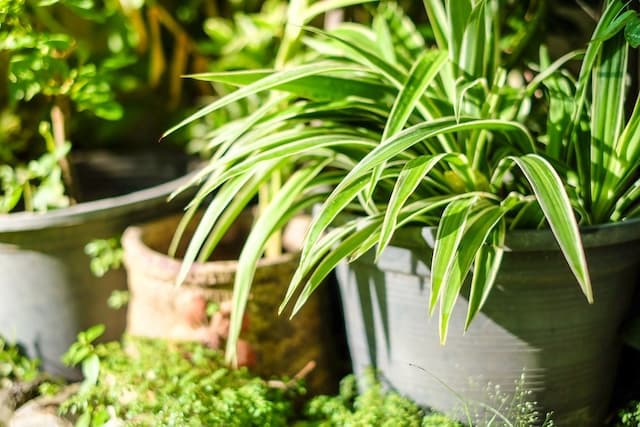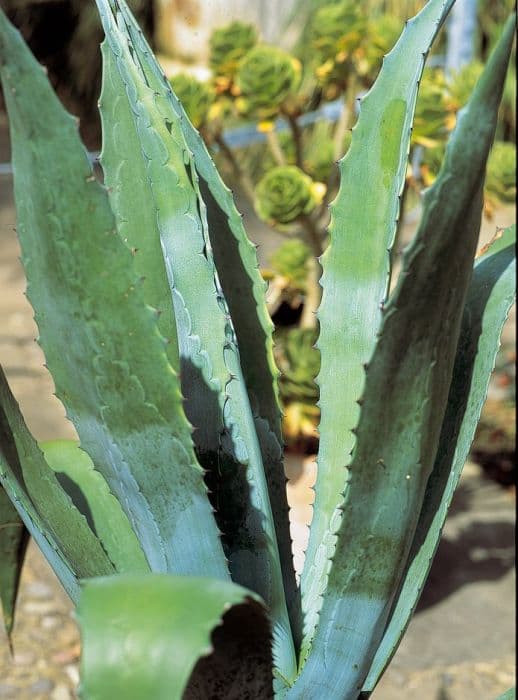Spineless yucca Yucca elephantipes

ABOUT
The Yucca elephantipes, commonly known as the spineless yucca or giant yucca, is a distinctive plant with a bold and striking appearance. It has a thick, woody trunk that resembles an elephant's foot at the base, from which it derives its name. The trunk is often branched, providing a strong framework for the foliage. The leaves of the spineless yucca are long, sword-shaped, and flexible, with a rich green color that can bring a tropical flair to any setting. These leaves sprout from rosettes at the tips of the branches and have smooth margins, making them quite different from other members of the yucca family that usually have sharp edges. The foliage has a leathery texture and may sometimes display a gentle arch, giving the plant a graceful silhouette. The spineless yucca can produce creamy white flowers that dangle in clusters from the center of the leaf rosettes, although flowering is rare when grown indoors. These bell-shaped flowers can add an elegant touch to the plant's overall appearance. The contrast between the soft blossoms and the rigid foliage provides an interesting visual dynamic. Overall, the spineless yucca's appearance is one of architectural beauty, with its combination of sturdy trunk and branches paired with the soft, dense greenery of its leaves.
About this plant
 Names
NamesFamily
Asparagaceae.
Synonyms
Spineless Yucca, Giant Yucca, Stick Yucca, Elephant’s Foot, Soft-Tip Yucca.
Common names
Yucca guatemalensis, Yucca gigantea.
 Toxicity
ToxicityTo humans
Spineless yucca is generally considered non-toxic to humans. However, if ingested, it may still cause mild discomfort, such as nausea or vomiting, due to its saponin content which can be irritating to the stomach. In rare cases or with sensitive individuals, handling the plant may lead to dermatitis.
To pets
Spineless yucca is toxic to pets, especially dogs and cats. Ingestion of the plant can lead to symptoms like vomiting, diarrhea, drooling, and lack of appetite. More severe consequences include potential liver damage and sapogenin compound poisoning, although large amounts of the plant need to be consumed for these effects to occur. It's advisable to keep pets away from spineless yucca to prevent any accidental ingestion.
 Characteristics
CharacteristicsLife cycle
Perennials
Foliage type
Evergreen
Color of leaves
Green
Flower color
White
Height
30 feet [9.14 meters]
Spread
15 feet [4.57 meters]
Plant type
Shrub
Hardiness zones
9
Native area
Central America
Benefits
 General Benefits
General Benefits- Low Maintenance: Yucca elephantipes is known for its hardiness and can thrive with minimal care, making it suitable for busy or novice gardeners.
- Drought Tolerant: It can withstand periods of drought once established, requiring less frequent watering compared to other plants.
- Architectural Aesthetic: With its bold, spiky leaves and substantial trunk, it adds a modern and structural element to indoor and outdoor spaces.
- Fast Growth: This plant is relatively fast-growing, quickly filling in spaces with its lush foliage.
- Adaptable: It can adapt to a range of lighting conditions from full sun to partial shade, making it versatile in various growing environments.
- Indoor and Outdoor Use: It can be grown both indoors as a houseplant and outdoors in suitable climates, offering flexibility for decoration and landscaping.
- Pest Resistant: Yucca elephantipes is resistant to many pests, minimizing the need for chemical treatments.
 Medical Properties
Medical Properties- Yucca elephantipes is not commonly known for its medicinal properties and is primarily used for ornamental purposes.
- In traditional medicine, some yucca species have been used for their potential anti-inflammatory and anti-arthritic effects, but specific evidence for Yucca elephantipes is lacking.
- It's important to note that while some yucca extracts are studied for their potential health benefits, there is insufficient scientific evidence to support the medicinal use of Yucca elephantipes.
- Consumption or use of Yucca elephantipes for medical purposes is not widely recognized or supported by substantial clinical research.
 Air-purifying Qualities
Air-purifying QualitiesThis plant is not specifically known for air purifying qualities.
 Other Uses
Other Uses- Alternative Paper Source: The fibers of Yucca elephantipes can be used to create a sustainable source of paper, reducing dependency on traditional wood pulp.
- Biodegradable Plastics: Extracts from the plant have potential use in producing biodegradable plastics, offering an eco-friendlier alternative to conventional plastics.
- Foliar Feed: Yucca extracts can be used as a foliar spray that acts as a surfactant, helping in the even distribution of sprays on plants.
- Soap and Shampoo: Yucca sap contains saponins which can be used to make natural soaps and shampoos with gentle cleansing properties.
- Photography: The sap of Yucca elephantipes, due to its unique chemical properties, has been used historically in alternative photography processes.
- Craft Material: Yucca leaves can be dried and braided or woven into baskets, mats, or sandals, making use of their fibrous and durable nature.
- Floral Arrangements: The straight, tall flower stalks can be used in large floral arrangements or as a part of dried flower crafts.
- Horticultural Mulch: Dried and shredded leaves can serve as a nutrient-rich mulch in gardens, providing soil health benefits.
- Fishing Nets: Traditional communities have used the strong fibers from Yucca elephantipes to weave fishing nets and other tools for catching fish.
- Waste Water Treatment: Because of its high absorption qualities and tolerance to contaminants, it can be used in constructed wetlands for treating wastewater.
Interesting Facts
 Feng Shui
Feng ShuiThe Spineless Yucca is not used in Feng Shui practice.
 Zodiac Sign Compitability
Zodiac Sign CompitabilityThe Spineless Yucca is not used in astrology practice.
 Plant Symbolism
Plant Symbolism- Purity: The yucca plant is often associated with purity due to its white flowers and their stark contrast against the green foliage.
- Protection: With its tough, sword-shaped leaves, the yucca symbolizes protection and can be used as a spiritual guard against negativity.
- Transformation: The yucca plant's ability to survive in harsh conditions and its resilience represents transformation and adaptability in challenging situations.
- Opportunity: The growth patterns of yuccas, often in new directions, symbolize opportunity and the idea of new possibilities.
- Persistence: Their hardiness and ability to withstand droughts make them a symbol of persistence and endurance in the face of adversity.
 Water
WaterThe Spineless Yucca should be watered thoroughly every 2-3 weeks, depending on the humidity and light conditions. Allow the top half of the soil to dry out before watering again. When you do water, pour water evenly around the base of the plant until it begins to drain from the bottom of the pot; this might equate to approximately 1 gallon for a large plant every few weeks. Do not let the plant sit in water as this can lead to root rot. It's essential to reduce watering during the winter months when the plant is in a dormant phase.
 Light
LightSpineless Yucca thrives in bright, indirect light but can also tolerate direct sunlight. Place it near a south-facing window or a spot where it can receive several hours of sunshine daily. This plant is adaptable, however, and can still grow in lower light conditions, although it will do so at a much slower rate.
 Temperature
TemperatureThe ideal temperature range for a Spineless Yucca is between 60 and 75 degrees Fahrenheit. It can survive temporarily in temperatures as low as 30 degrees Fahrenheit but prolonged exposure to cold can be harmful. Ensure that the plant is not subject to drafts and sudden temperature fluctuations for optimal health.
 Pruning
PruningPrune the Spineless Yucca to remove dead or damaged leaves and to maintain its shape. Pruning is best done in the spring before the growing season begins. Cut back any overgrowth or unwieldy branches directly above a leaf node to encourage new growth. Pruning once a year is typically sufficient unless the plant has sustained damage or is becoming too large for its space.
 Cleaning
CleaningAs needed
 Soil
SoilSpineless Yucca thrives in a well-draining soil mix composed of equal parts potting soil, coarse sand, and perlite or pumice. The ideal soil pH for Spineless Yucca should be between 5.5 and 7.5.
 Repotting
RepottingSpineless Yucca should be repotted every two to three years, or when the plant becomes root-bound and the roots start to outgrow the current container.
 Humidity & Misting
Humidity & MistingSpineless Yucca prefers low to average home humidity levels, making it quite adaptable to typical indoor environments without the need for additional humidity.
 Suitable locations
Suitable locationsIndoor
Place Spineless Yucca in bright, indirect light inside.
Outdoor
Plant Spineless Yucca in full sun to partial shade outside.
Hardiness zone
9-11 USDA
 Life cycle
Life cycleThe life of the Yucca elephantipes, commonly known as the Spineless Yucca or Giant Yucca, begins with germination, where seeds sprout in warm, moist soil conditions. As a seedling, it develops long, pointed leaves and a central stem that eventually becomes woody. During the juvenile stage, the plant grows rapidly and may start to form a thickened, trunk-like stem that gives it the "elephantipes" descriptor. Once it reaches maturity, the Spineless Yucca can produce white, bell-shaped flowers in clusters on tall stalks above the foliage, typically during late spring or summer. After pollination, these flowers develop into seed capsules containing the plant's seeds, ready to start the next generation. Over many years, the mature Yucca may grow to be quite tall and can even develop branching trunks with proper care and conditions.
 Propogation
PropogationPropogation time
Spring-Early Summer
Propogation: The most popular method of propagation for the Yucca elephantipes, commonly known as the spineless yucca or giant yucca, is through stem cuttings. This is often done in the Spring or early Summer when the plant's growth is most active. To propagate, select a healthy and straight section of the stem approximately 4 to 6 inches (10 to 15 centimeters) in length. Cut this section with a clean, sharp knife to reduce the risk of infection. Allow the cutting to dry for a few days until the cut end calluses over to prevent rot. Then plant the cutting in a pot filled with a well-draining soil mix, ensuring that it stands upright. Water minimally until roots develop, which typically takes a few weeks. Once established, the new yucca can be treated as a mature plant.









